When I was asked to speak at Adelaide’s 2nd public demonstration in opposition to the Western Australian shark cull, I seized the opportunity. Prior to the first national day of action in January, I had concluded that the Barnett/Buswell ‘catch and kill’ policy was inhumane, unnecessary and unscientific. As an independent researcher, documentary filmmaker and marine conservationist, I was more than happy to share my perspective on the foreshore at Moseley Square, Glenelg with a few hundred ocean-loving South Australians.
The following piece is derived from the speech I gave back in February. It was a pleasure to share the opportunity with a variety of speakers, among them shark attack survivor and marine conservationist Rodney Fox, fisherman/comedian Dwayne Mullet, Animal Liberation activist Emma Dawson and politician Mark Aldridge.
The Western Australian Government had already offended my democratic spirit by not listening to protesters or community polls. I was equally appalled as I discovered the extent to which they chose to work against much of the scientific evidence presented to them when forming their policy.
In late January, results of a new poll by UMR research were published in the Sydney Morning Herald. A few points from this survey screamed out:
- 83 per cent of Australians haven’t changed how often they swim, surf or take part in other recreational activities in the ocean because of the risk of shark attack
- 78 per cent of the 500 adults interviewed feel safe from shark attacks when going into the ocean
- 82 per cent don’t think that sharks should be killed and say people enter the water at their own risk
- only 15 per cent favour hunting down and killing sharks to make beaches safer
This brought me to these questions: how much do those supporting shark killing know about sharks, and how much time do they spend in or on the water?
There is always room for improved public education, but as for politicians, it seems like they can often be much slower learners. Is it stubborness? Is it pride? Is it a willingness to accept the result of a democratic election, only to deny representative, democratic governance once elected?
In 2012, a Bond University report recommended against the use of drum lines.
In 2013, over 100 scientists and professionals who work with sharks signed an open letter to the WA Government calling for the use of non-lethal shark protection measures and increased research effort.
Then in January 2014, the ‘catch and kill’ policy was implemented. Through to the end of April, all sharks caught on drum lines greater than 3m in length were ordered to be shot (if not already drowned) and disposed of. The Government has received a waiver to allow the killing of Great White Sharks in this way. So much for their ‘vulnerable’ status, and their protection as a migratory and marine species under Federal Australian environmental law (see the EPBC Act for the specifics).
Since speaking at the previous rally, I’d had some more time to look into the previous use of drum lines (baited hooks attached to floats and anchors) in Australia. In the state of Queensland, drum lines and shark nets have been in place since 1962. People involved with that scheme will tell you that it’s been successful, with only one human life lost at a baited and netted beach since implementation. The lines and nets combined kill 500-700 sharks annually, with bycatch including numerous protected species including dolphin, dugong and sea turtles. Successful for people perhaps, but at great expense to the surrounding ecosystem.
It is my belief that users of the marine environment need to take responsibility for their own safety. All frequent users of the marine environment should be informed of ways to improve their personal safety. These include increasing their understanding of shark behaviour (to avoid periods and conditions where shark attack risk is elevated) and knowledge of available protection technology.
Of the seven fatalities in WA since 2010, it’s worth considering the activities each victim was engaged in.
- Four were surfing or bodyboarding and taken from the surface (likely resembling seals or floating carcasses, both arousing the interest of Great White Sharks)
- One was spear-fishing (which can often involve berleying to attract fish and the letting of blood of captured fish into the water)
- One was diving on a productive crayfish reef (hey, it’s nature’s pantry too, expect predators)
- One was swimming out to a buoy 500m offshore (the deeper the water, the greater the comfort of pelagic sharks and the higher the risk of attack from below)
As a snorkeler and free-diver, I know that I am more exposed to potential shark attack than the average swimmer. One of the ways I choose to lower my shark attack risk is to wear a Shark Shield. It’s an electro-magnetic shark deterrent which has been on the market since the late 1990’s. Different models are available for divers, swimmers and surfers. Unfortunately, the surfing model hasn’t proven as popular as those used by divers and snorkelers, and it’s only used by a minority in the surf community. Scientific research by SARDI has shown them to be an effective deterrent, but it’s not an absolute guarantee.
Coincidentally, Shark Shield (the company) recently relocated to Western Australia. How many Shark Shields could the government effectively distribute to surfers and spear-fishermen for the cost of their elaborate drum line scheme? Was this option ever considered around the policy table?
This is just one of many non-lethal alternative strategies which in my opinion could bear much sweeter and longer-lasting fruit. Personally, I believe we should be advocating for a combination of
- increased investment in shark tagging, tracking and notification programs
- increased public education effort re: scale of risk
- increased use of personal shark protection measures for surfers, divers and spear-fishers
Please don’t be mislead by tabloid headlines and sensational breaching photographs. Shark attack risk for humans is low and always has been. The same can’t be said for human attack risk on sharks, however. That pressure has grown exponentially over the past century, greatly enhanced by increasing human populations and industrialised fishing materials and methods. Estimates of the global shark catch range from 70 to 100 million animals per year, and many animals are taken purely for their fins, their bodies left at sea or laid to waste.
Sharks deserve our respect and our protection, not persecution.


A well-written article, Dan. My apologies for missing the rally today. I had already made plans for diving at Second Valley today. Highlights of my dive were sighting a seal, small shark, two cuttlefish and a leafy seadragon.